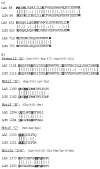The Lassa fever virus L gene: nucleotide sequence, comparison, and precipitation of a predicted 250 kDa protein with monospecific antiserum
- PMID: 9049403
- PMCID: PMC2405892
- DOI: 10.1099/0022-1317-78-3-547
The Lassa fever virus L gene: nucleotide sequence, comparison, and precipitation of a predicted 250 kDa protein with monospecific antiserum
Abstract
The large (L) RNA segment of Lassa fever virus (LAS) encodes a putative RNA-dependent RNA polymerase (RdRp or L protein). Similar to other arenaviruses, the LAS L protein is encoded on the genome-complementary strand and is predicted to be 2218 amino acids in length (253 kDa). It has an unusually large non-coding region adjacent to its translation start site. The LAS L protein contains six motifs of conserved amino acids that have been found among arenavirus L proteins and core RdRp of other segmented negative-stranded (SNS) viruses (Arena-, Bunya- and Orthomyxoviridae). Phylogenetic analyses of the RdRp of 20 SNS viruses reveals that arenavirus L proteins represent a distinct cluster divided into LAS-lymphocytic choriomeningitis and Tacaribe-Pichinde virus lineages. Monospecific serum against a synthetic peptide corresponding to the most conserved central domain precipitates a 250 kDa product from LAS and lymphocytic choriomeningitis virus-infected cells.
Figures



References
-
- Auperin DD, Compans RW, Bishop DHL. Nucleotide sequence conservation at the 3′ termini of the virion RNA species of new world and old world arenaviruses. Virology. 1982;121:200–203. - PubMed
-
- Auperin DD, Sasso DR, McCormick JB. Nucleotide sequence of the glycoprotein gene and intergenic region of the Lassa virus S genome RNA. Virology. 1986;154:155–167. - PubMed
-
- Bowen MD, Peters CJ, Nichol ST. The phylogeny of New World (Tacaribe complex) arenaviruses. Virology. 1996;219:285–290. - PubMed
-
- Clegg JCS. Molecular phylogeny of the arenaviruses and guide to published sequence data. In: Salvato MS, editor. The Arenaviridae. New York: Plenum Press; 1993. pp. 175–187.
Publication types
MeSH terms
Substances
Associated data
- Actions
- Actions
- Actions
- Actions
- Actions
- Actions
- Actions
- Actions
- Actions
- Actions
- Actions
- Actions
- Actions
- Actions
- Actions
- Actions
- Actions
- Actions
- Actions
Grants and funding
LinkOut - more resources
Full Text Sources
Research Materials

